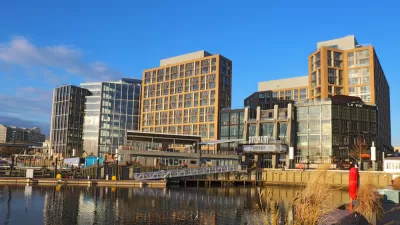A recent article in Washington City Paper pushes back on the notion that the ill effects of gentrification are overblown. Resurgent cities must, according to the article, find ways to achieve the benefits of gentrification—without the displacement.

Aaron Wiener responds to an article in The Economist proclaiming, "Bring on the hipsters" and "Gentrification is good for the poor."
First, Wiener shows some sympathy for members of the media who buy into this argument: "The notion is tempting to reporters for a number of reasons. It's counter-intuitive. It aligns neatly with an increasingly popular form of neoliberal urbanism that says the key to creating better, more affordable cities is to do away with zoning limits, parking minimums, and other regulations and simply let the cities grow. And it absolves us of guilt: We, the youngish reporters of America's major cities, are by and large the gentrifiers, as opposed to the displaced."
Wiener notes that The Economist isn't the only publication to make a similar argument—Slate also recently posted an article titled "The Myth of Gentrification."
The problem, according to Wiener, is that neither of the articles account for the fact that people are actually being displaced. Weiner goes on to cite specific examples from Washington, D.C., noting that even if only a few cities around the country are experiencing displacement at the same scale as the nation's capital, that doesn't warrant ignoring the realities of the challenge.
Writes Wiener: "As a city, we still haven't found a way to bring the benefits of gentrification without the displacement. No one has. It's the fundamental challenge of our resurgent city, and resurgent cities across the country. But it's not a very good excuse for pretending the problem doesn't exist."
FULL STORY: The “Gentrification Myth” Myth

Alabama: Trump Terminates Settlements for Black Communities Harmed By Raw Sewage
Trump deemed the landmark civil rights agreement “illegal DEI and environmental justice policy.”

Planetizen Federal Action Tracker
A weekly monitor of how Trump’s orders and actions are impacting planners and planning in America.

The 120 Year Old Tiny Home Villages That Sheltered San Francisco’s Earthquake Refugees
More than a century ago, San Francisco mobilized to house thousands of residents displaced by the 1906 earthquake. Could their strategy offer a model for the present?

Ken Jennings Launches Transit Web Series
The Jeopardy champ wants you to ride public transit.

BLM To Rescind Public Lands Rule
The change will downgrade conservation, once again putting federal land at risk for mining and other extractive uses.

Indy Neighborhood Group Builds Temporary Multi-Use Path
Community members, aided in part by funding from the city, repurposed a vehicle lane to create a protected bike and pedestrian path for the summer season.
Urban Design for Planners 1: Software Tools
This six-course series explores essential urban design concepts using open source software and equips planners with the tools they need to participate fully in the urban design process.
Planning for Universal Design
Learn the tools for implementing Universal Design in planning regulations.
Clanton & Associates, Inc.
Jessamine County Fiscal Court
Institute for Housing and Urban Development Studies (IHS)
City of Grandview
Harvard GSD Executive Education
Toledo-Lucas County Plan Commissions
Salt Lake City
NYU Wagner Graduate School of Public Service





























